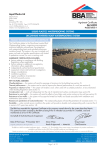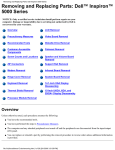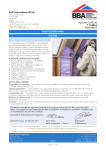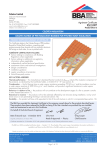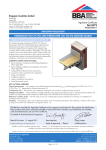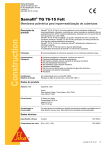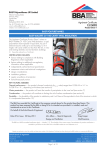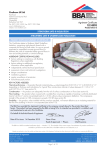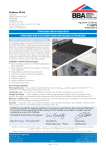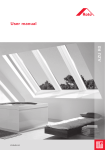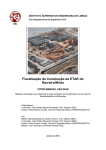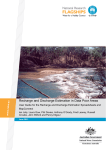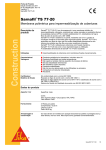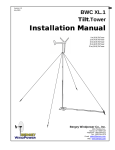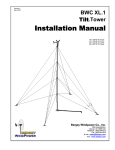Download pdf - Sika Liquid Plastics
Transcript
APPROVAL INSPECTION TESTING CERTIFICATION Sika Liquid Plastics Sika House Miller Street Preston Lancashire PR1 1EA Tel: 01772 259781 Fax: 01772 255670 TECHNICAL APPROVALS FOR CONSTRUCTION Agrément Certificate 14/5147 e-mail: [email protected] website: www.liquidplastics.co.uk Product Sheet 1 SIKA LIQUID PLASTICS ROOF SYSTEMS SIKA LIQUID PLASTICS BUILT-UP ROOF SYSTEMS This Agrément Certificate Product Sheet (1) relates to Sika Liquid Plastics Built-Up Roof Systems, comprising adhesives, vapour control layers, insulation, carrier membrane and one-component, moisture-activated, reinforced aliphatic polyurethane liquid-applied roof waterproofing membranes, for use as waterproofing and insulation systems on flat and sloping roofs with limited access. (1) Hereinafter referred to as ‘Certificate’. CERTIFICATION INCLUDES: • factors relating to compliance with Building Regulations where applicable • factors relating to additional non-regulatory information where applicable • independently verified technical specification • assessment criteria and technical investigations • design considerations • installation guidance • regular surveillance of production • formal three-yearly review. KEY FACTORS ASSESSED Weathertightness — the systems will resist the passage of moisture to the interior of the building (see section 6). Thermal performance — the systems can be used to improve the thermal performance of a roof (see section 7). Condensation risk — roofs incorporating the systems will adequately limit the risk of interstitial and surface condensation (see section 8). Properties in relation to fire — in the opinion of the BBA, the systems, when used in a suitable specification, will enable a roof to be unrestricted under the Building Regulations (see section 9). Resistance to wind uplift — the systems will enable a roof to be unrestricted under Building Regulations (see section 10). Resistance to foot traffic — the systems will accept, without damage, the limited foot traffic and loads associated with installation and maintenance (see section 11). Durability — under normal service conditions the systems will provide a durable waterproof covering with a service life of 10, 15, 20 or 25 years dependent on the waterproofing system used (see section 13). The BBA has awarded this Certificate to the company named above for the systems described herein. These systems have been assessed by the BBA as being fit for their intended use provided they are installed, used and maintained as set out in this Certificate. On behalf of the British Board of Agrément Date of First issue: 13 August 2014 Simon Wroe Head of Approvals — Materials Claire Curtis-Thomas Chief Executive The BBA is a UKAS accredited certification body — Number 113. The schedule of the current scope of accreditation for product certification is available in pdf format via the UKAS link on the BBA website at www.bbacerts.co.uk Readers are advised to check the validity and latest issue number of this Agrément Certificate by either referring to the BBA website or contacting the BBA direct. British Board of Agrément Bucknalls Lane Watford Herts WD25 9BA ©2014 Page 1 of 12 tel: 01923 665300 fax: 01923 665301 e-mail: [email protected] website: www.bbacerts.co.uk Regulations In the opinion of the BBA, Sika Liquid Plastics Built-Up Roof Systems, if installed, used and maintained in accordance with this Certificate, can satisfy or contribute to satisfying the relevant requirements of the following Building Regulations (the presence of a UK map indicates that the subject is related to the Building Regulations in the region or regions of the UK depicted): The Building Regulations 2010 (England and Wales) (as amended) Requirement: B4(2) External fire spread Comment: On a suitable substructure, the use of the systems will enable a roof to be unrestricted under this Requirement. See section 9 of this Certificate. Requirement: C2(b) Resistance to moisture Comment: Requirement: C2(c) Resistance to moisture The systems, including joints, will enable a roof to meet this Requirement. See section 6.1 of this Certificate. Comment: The vapour control layer component of the systems can contribute to enabling a roof to satisfy this Requirement. See sections 8.1, 8.3 and 8.4 of this Certificate. Requirement: L1(a)(i) Conservation of fuel and power Comment: Regulation: 7 Materials and workmanship Comment: Regulation: 26 CO2 emission rates for new buildings The systems are acceptable. See sections 7.2 and 7.3 of this Certificate. The systems are acceptable. See section 13 and the Installation part of this Certificate. The systems can enable a construction to meet the requirements of this Regulation. See sections 7.2 and 7.3 of this Certificate. Comment: The Building (Scotland) Regulations 2004 (as amended) Regulation: 8(1)(2) Regulation: Standard: 9 2.8 3.10 3.15 6.1 6.2 7.1(a)(b) Statement of sustainability The systems can contribute to meeting the relevant requirements of Regulation 9, Standards 1 to 6 and therefore will contribute to a construction meeting a bronze level of sustainability as defined in this Standard. In addition, the systems can contribute to a construction meeting a higher level of sustainability as defined in this Standard, with reference to clauses 7.1.4(1)(2) [Aspects 1(1)(2) and 2(1)], 7.1.6(1)(2) [Aspects 1(1)(2) and 2(1)] and 7.1.7(1)(2) [Aspect 1(1)(2)]. See sections 7.2 and 7.3 of this Certificate. Comment: Regulation: Carbon dioxide emissions Building insulation envelope The systems can contribute to satisfying the requirements of these Standards, with reference to all or parts of clauses 6.1.2(2), 6.1.6(1), 6.2.1(1)(2), 6.2.3(1), 6.2.4(2), 6.2.5(2), 6.2.6(1), 6.2.7(1), 6.2.8(1)(2), 6.2.9(1)(2), 6.2.10(1)(2), 6.2.11(1)(2), 6.2.12(2) and 6.2.13(1)(2). See sections 7.2 and 7.3 of this Certificate. Comment: Standard: Condensation The vapour control layer component of the systems will enable a roof to satisfy this Standard, with reference to clauses 3.15.1(1), 3.15.3(1), 3.15.5(1) and 3.15.6(1). See sections 8.1, 8.3 and 8.5 of this Certificate. Comment: Standard: Standard: Precipitation The use of the systems, including joints, will enable a roof to meet the requirements of this Standard, with reference to clauses 3.10.1(1)(2) and 3.10.7(1)(2). See section 6.1 of this Certificate. Comment: Standard: Building standards applicable to construction Spread from neighbouring buildings The systems, when applied to a suitable substructure, are regarded as having low vulnerability under clause 2.8.1(1)(2) of this Standard. See section 9 of this Certificate. Comment: Standard: Durability, workmanship and fitness of materials The use of the systems satisfies the requirements of this Regulation. See sections 12 and 13 and the Installation part of this Certificate. Comment: 12 Building standards applicable to conversions All comments given for these systems under Regulation 9, Standards 1 to 6 also apply to this Regulation, with reference to clause 0.12.1(1)(2) and Schedule 6(1)(2). Comment: (1) Technical Handbook (Domestic). (2) Technical Handbook (Non-Domestic). The Building Regulations (Northern Ireland) 2012 Regulation: 23(a)(i)(iii)(b) Fitness of materials and workmanship Comment: Regulation: 28(b) Resistance to moisture and weather The systems are acceptable. See section 13 and the Installation part of this Certificate. Tests for water resistance indicate that the systems, including joints, meet the requirements of this Regulation. See section 6.1 of this Certificate. Comment: Regulation: Comment: 29 Condensation The systems can contribute to a roof meeting this Regulation. See sections 8.1 and 8.3 of this Certificate. Page 2 of 12 Regulation: 36(b) Regulation: Regulation: External fire spread Tests indicate that, on suitable substructures, the use of the systems will enable a roof to be unrestricted under the requirements of this Regulation. See section 9 of this Certificate. Comment: 39(a)(i) 40(2) Comment: Conservation measures Target carbon dioxide Emissions Rate Roofs incorporating the systems can satisfy or contribute to satisfying these Regulations. See sections 7.2 and 7.3 of this Certificate. Construction (Design and Management) Regulations 2007 Construction (Design and Management) Regulations (Northern Ireland) 2007 Information in this Certificate may assist the client, CDM co-ordinator, designer and contractors to address their obligations under these Regulations. See sections: 1 Description (1.4), 3 Delivery and site handling (3.3) and 15 Precautions (15.1 and 15.2) of this Certificate. Additional Information NHBC Standards 2014 NHBC accepts the use of Sika Liquid Plastics Built-Up Roof Systems, provided they are installed, used and maintained in accordance with this Certificate, in relation to NHBC Standards, Chapter 7.1 Flat roofs and balconies. NHBC does not accept systems using waterproofing specifications with an expected durability of less than 20 years. Registered office The registered office of the Certificate Holder is Sika Ltd, Watchmead, Welwyn Garden City, Hertfordshire, AL7 1BQ. Registered in England: 226822. Technical Specification 1 Description 1.1 The Sika Liquid Plastics Built-Up Roof Systems comprise the following components: • Decothane Base Coat and Top Coat — single-component, liquid-applied, moisture activated, aliphatic polyurethane roof covering membranes (the subject of BBA Certificate 92/2803 and ETA 03/0052) • Decaflex — single-component, liquid-applied, moisture-activated, aromatic polyurethane roof covering membrane (the subject of ETA 13/0118) • Sika Reemat Premium reinforcing mat — a non-woven glassfibre reinforcing mat, for use as a reinforcement embedded in the urethane while still wet, and available for use in strips to cover individual cracks, joints or details • Decotherm — a polyisocyanurate foam insulation board with glassfibre facing on both sides • Carrier Membrane SA — a multi-layer, self-adhesive polymer modified bitumen membrane with an aluminium foil/ random fibre top layer, for use over the insulation and beneath the waterproofing system • S-Vap 5000E SA — a multi-layer, self-adhesive vapour control layer made of polymer modified bitumen with a glassfibre mat reinforcement and an aluminium foil as top layer, for use in the fully-adhered system • S-Vap 500E — a recycled polyethylene vapour control layer for use when the insulation is mechanically fastened • S-Vap Jointing Tape — to bond adjacent layers of S-Vap 500E • Decostik SP — a humidity-hardening, one-pack polyurethane adhesive to bond insulation boards to existing waterproofing and S-Vap 5000E SA • Decostik Foaming Adhesive — a solvent-free, two-part liquid-applied urethane adhesive to bond insulation boards on existing waterproofing • Sika Mechanical Fastenings — for use in fastening the insulation boards • Sika Bonding Primer — a two-part primer for the preparation of porous substrates • Sikalastic Metal Primer — a two-part primer for the treatment of previously untreated metal surfaces and spot priming of areas of corroded metal after preparation • Primer 600 — for use in preparing substrates prior to installation of the self-adhesive membranes • Skid-inhibiting Grit — to provide a skid-inhibiting finish to final coat and on existing waterproofing. 1.2 The liquid-applied components have the nominal characteristics given in Table 1. Page 3 of 12 Table 1 Nominal characteristics of liquid-applied components Characteristic (unit) Grade Decothane Top Coat Decothane Base Coat Decaflex 2.00 5.00 2.75 5.00 6.00 24.00 White, Dove Grey, Shale Grey and Slate Grey Red Storm Grey, Cloud Grey and Chrome Green Drying time at 22°C/52% RH (hours) touch time through cure Standard colour 1.3 The levels of use categories in accordance with ETAG 005 : 2000 Parts 1 and 6 from ETAs 03/0052 and 13/0118 are given in Table 2: Table 2 Levels of use categories Use categories Levels External fire performance Decaflex Decothane Omega 15 Decothane Gamma 20 Decothane Delta 25 BROOF(t1) BROOF(t1) BROOF(t1) BROOF(t1) BROOF(t4) BROOF(t2) BROOF(t2) BROOF(t3) BROOF(t3) BROOF(t4) Reaction to fire Categorisation by working life Categorisation by climatic zone Euroclass E Euroclass E Euroclass E Euroclass E W2 (10 years) W3 (25 years) W3 (25 years) W3 (25 years) M (moderate) S (severe) M (moderate) S (severe) M (moderate) S (severe) M (moderate) S (severe) P3 P4 P4 P4 P4 P4 P4 P4 S1 (<5%) to S4 (>30%) S1 (<5%) to S4 (>30%) S1 (<5%) to S4 (>30%) S1 (<5%) to S4 (>30%) TL3 (–20°C) TH4 (90°C) TL3 (–20°C) TH4 (90°C) TL3 (–20°C) TH4 (90°C) TL3 (–20°C) TH4 (90°C) >50 kPa >50 kPa >50 kPa >50 kPa None contained None contained None contained None contained Categorisation by imposed loads most compressible substrate least compressible substrate Categorisation by roof slope Categorisation by surface temperature lowest highest Resistance to wind loads Statement on dangerous substances (1) (1) Dangerous substances as listed in the European Commission database. 1.4 The vapour control layers and carrier membrane are supplied in rolls and are manufactured with the nominal characteristics given in Table 3. Table 3 Nominal characteristics of membranes Nominal characteristic (unit) Value S-Vap 500E S-Vap 5000E SA Carrier Membrane SA Thickness (mm) 0.15 0.60 0.80 Width (m) 5.00 1.38 1.00 Length (m) 25 30 30 Mass per unit area (kg·m ) 0.15 0.60 1.20 Water vapour transmission — equivalent air layer thickness Sd (m) 100 >1800 1500 Tensile strength (N per 50 mm) longitudinal transverse 130 130 440 440 150 150 60 60 100 100 70 70 –2 Nail tear (N) longitudinal transverse 1.5 Decotherm is a polyisocyanurate foam insulation with glassfibre facing on both sides. Decotherm has nominal characteristics given below and is available as flat or tapered board. Characteristic (unit) Length (mm) Width (mm) Thickness (mm) Density (kg·m–3) Value 1200 600 25, 40, 50, 60, 70, 75, 80, 90, 100, 120, 130 32 Page 4 of 12 Compressive stress at 10% deformation CS (10\Y) 150 –1 –1 Thermal conductivity 90/90 values (W·m ·K ) 80 mm thickness 0.026 80 mm to <120 mm thickness 0.025 120 mm 0.024 1.6 Decotrim roof trims are a range of factory fabricated items for use as ancillary items in conjunction with the systems. The following trims are available: • edge trim A • edge trim B • edge trim C • drip trim D • internal corner trim • external corner trim • counter flashing • termination bar. 2 Manufacture 2.1 The liquid components of the system are manufactured by a batch blending process. 2.2 The insulation boards are manufactured by raw materials being injected onto a glassfibre facer on a conveyor belt. The exothermic reaction expands the foam, which consequently comes into contact with the other glassfibre facer. An automated process cures and cuts the product to the required size. 2.3 As part of the assessment and ongoing surveillance of product quality, the BBA has: • agreed with the manufacturer the quality control procedures and product testing to be undertaken • assessed and agreed the quality control operated over batches of incoming materials • monitored the production process and verified that it is in accordance with the documented process • evaluated the process for management of nonconformities • checked that equipment has been properly tested and calibrated • undertaken to carry out the above measures on a regular basis through a surveillance process, to verify that the specifications and quality control operated by the manufacturer are being maintained. 2.4 The management system of Sika Liquid Plastics, which produces the waterproofing component of the systems, has been assessed and registered as meeting the requirements of BS EN ISO 9001 : 2008 and BS EN ISO 14001 : 2004 by BSI (Certificates FM 588020 and EMS 588023 respectively). 3 Delivery and site handling 3.1 The liquid waterproofing components are delivered to site in 15 litre tins bearing the product’s name, batch number and the BBA logo incorporating the number of this Certificate. 3.2 The liquid waterproofing components, adhesives and primers should be stored in a dry, shaded area, above freezing point and away from ignition sources. Storage temperatures of between 10°C and 25°C will give the product a shelf-life of 9 months; at higher temperatures the shelf-life will reduce progressively. Once opened, tins should be used within two or three days. 3.3 The liquid waterproofing components, adhesives and primers are all classified under The Chemicals (Hazard Information and Packaging for Supply) Regulations 2009 (CHIP4)/Classification, Labelling and Packaging of Substances and Mixtures (CLP Regulation) 2009 and bear the appropriate hazard warning label. The flashpoints and classifications are given in Table 4. Table 4 Flashpoint and hazard classifications Material Flashpoint (°C) Classification Decothane Base Coat 62 Harmful, Dangerous for the environment Decothane Top Coat 62 Harmful, Dangerous for the environment Decaflex 44 Harmful, Dangerous for the environment Decostik SP Non-flammable Harmful Decostik Foaming Adhesive Part A Part B Non-flammable 177 Harmful Irritant Sika Bonding Primer Part A Part B Non-flammable Non-flammable No classification Irritant Sikalastic Metal Primer Part A Part B 43 32 Irritant, Dangerous for the environment Corrosive, Dangerous for the environment Primer 600(1) –20 Highly flammable, Irritant, Dangerous for the environment (1) This component must be stored in accordance with The Dangerous Substances and Explosive Atmospheres Regulations 2002. 3.4 Decotherm boards are delivered to site in packs shrink-wrapped in polythene. Each pack carries a label bearing the Certificate holder’s name and the BBA logo incorporating the number of this Certificate. Page 5 of 12 3.5 The boards must be stored flat, off the ground on a clean, dry, level surface, under cover, out of direct sunlight and not in areas subject to elevated temperatures. 3.6 In elevated temperatures there may be a risk of bowing caused by a thermal gradient across the board. 3.7 The vapour control layers and carrier membrane are delivered to site as rolls in paper wrappings, bearing the product name, Certificate holder’s name and the BBA logo incorporating the number of this Certificate. Assessment and Technical Investigations The following is a summary of the assessment and technical investigations carried out on Sika Liquid Plastics Built-Up Roof Systems. Design Considerations 4 General 4.1 Sika Liquid Plastics Built-Up Roof Systems are satisfactory for use as liquid-applied waterproofing and bonded insulation systems on flat and sloping roofs with limited access. 4.2 The systems are suitable for use on decks and substrates of concrete, steel, timber, plywood, bituminous membranes, asphalt and some approved single ply membranes. 4.3 Limited access roofs are defined for the purposes of this Certificate as those subjected only to pedestrian traffic for maintenance of the roof covering, cleaning of gutters, etc. Where traffic in excess of this is envisaged, special precautions, such as additional protection to the membrane, must be taken; for example, carborundum grit, skidinhibiting finish incorporated into an additional bond coat. 4.4 Flat roofs are defined for the purpose of this Certificate as those having a minimum finished fall of 1:80. Pitched roofs are defined as those having falls in excess of 1:6. 4.5 When designing flat roofs, twice the minimum finished fall should be assumed unless a detailed analysis of the roof is available, including overall and local deflection, direction of falls, etc. 4.6 Decks to which the product is to be applied must comply with the relevant requirements of BS 6229 : 2003, BS 8217 : 2005 and, where appropriate, NHBC Standards 2014, Chapter 7.1. 5 Practicability of installation Installation of the system must be carried out only by specialist roofing contractors trained and approved by the Certificate holder. 6 Weathertightness 6.1 Results of tests confirm that the systems will adequately resist the passage of moisture to the inside of the building and so meet or comply with the relevant requirements of the national Building Regulations: England and Wales — Approved Document C, Requirement C2(b), Section 6 Scotland — Mandatory Standard 3.10, clauses 3.10.1(1)(2) and 3.10.7(1)(2) (1) Technical Handbook (Domestic). (2) Technical Handbook (Non-Domestic). Northern Ireland — Regulation 28(b). 6.2 The systems are impervious to water and, when used as described, will give a weathertight roofing capable of accepting minor movement without damage. 6.3 To achieve a weathertight coating it is essential that the application rate is as quoted in the Certificate holder’s literature for the relevant system. 7 Thermal performance 7.1 Calculations of thermal transmittance (U value), must be carried out in accordance with BS EN ISO 6946 : 2007 and BRE Report (BR 443 : 2006) Conventions for U-value calculations, using the declared thermal conductivity (90/90 value) of the insulation components as shown below. Insulation thickness (mm) 80 mm thickness 80 mm to <120 mm thickness 120 mm Thermal conductivity — 90/90 values (W·m–1·K–1) 0.026 0.025 0.024 7.2 The U value of a completed roof will depend on the thickness of insulation used, and the insulating value of other roof components/layers. Example U values for a roof incorporating the system are shown in Tables 5 and 6. Page 6 of 12 Table 5 Example U values (insulation bonded) U value requirement (W·m–2·K–1) Insulation thickness requirement (mm) Concrete Timber Metal 0.13 170 170 175 0.16 135 135 145 0.18 120 120 125 0.20 115 110 120 0.25 90 90 95 Table 6 Example U values (insulation mechanically fastened) U value requirement (W·m–2·K–1) Insulation thickness requirement (mm) Concrete Timber Metal 0.13 190 190 195 0.16 145 150 150 0.18 130 125 140 0.20 120 120 120 0.25 95 95 100 7.3 The system can contribute to maintaining continuity of thermal insulation at junctions between elements and openings. For Accredited Construction Details, the corresponding psi values in BRE Information Paper IP1/06 Assessing the effects of thermal bridging at junctions and around openings, Table 6, may be used in carbon emission calculations in Scotland and Northern Ireland. Detailed guidance for other junctions and on limiting heat loss by air infiltration can be found in: England and Wales — Approved Documents to Part L and, for new thermal elements to existing buildings, Accredited Construction Details (version 1.0). See also SAP 2009, Appendix K, and the iSBEM User Manual for new-build Scotland — Accredited Construction Details (Scotland) Northern Ireland — Accredited Construction Details (version 1.0). 8 Condensation risk Interstitial condensation 8.1 Roofs incorporating either S-Vap 500E or S-Vap 5000E SA will adequately limit the risk of interstitial condensation when they are designed and constructed in accordance with BS 5250 : 2011, Appendix D and Appendix H, and BRE Report (BR 262 : 2002) Thermal insulation: avoiding risks in England and Wales. 8.2 For the purposes of assessing the risk of interstitial condensation, the Decotherm boards’ insulation core vapour resistivity may be taken as approximately 300 MN·s·g–1·m–1. The vapour resistance of the of the glass tissue may be taken as 3 MN·s·g–1·m–1 (sd = 0.6 m). 8.3 Where an effective vapour control layer cannot be guaranteed, eg owing to a large number of penetrations through the layer, the risk of condensation must be assessed in accordance with BS 6229 : 2003, Annex A. Surface condensation 8.4 Roofs will adequately limit the risk of surface condensation when the thermal transmittance (U value) does not exceed 0.35 W·m–2·K–1 at any point and the junctions with other elements are designed in accordance with section 7.3. 8.5 Roofs will adequately limit the risk of surface condensation when the thermal transmittance (U value) does not exceed 1.2 W·m–2·K–1 at any point. Guidance may be obtained from BS 5250 : 2011, Appendix H and BRE Report (BR 262 : 2002). 8.6 Alternatively, a detailed assessment in accordance with BS 5250 : 2002, Annex D, and BS EN ISO 13788 : 2002, Section 5 can be carried out to determine the likelihood of surface condensation and mould growth. 9 Properties in relation to fire 9.1 When tested in accordance with ENV 1187 : 2002, test 4, and classified to BS EN 13501-5 : 2005, a system comprising a 18 mm thick plywood substrate, S-Vap 5000E SA, an 80 mm thick Decotherm insulation board bonded with Decostik SP, Primer 600, Carrier Membrane SA and the Gamma 20 System achieved a BROOF(t4) classification. 9.2 The designation of other specifications, for example when used on combustible substrates, should be confirmed by: England and Wales — test or assessment in accordance with Approved Document B, Appendix A, Clause 1 Page 7 of 12 Scotland — test to conform to Mandatory Standard 2.8, clause 2.8.1(1)(2) (1) Technical Handbook (Domestic). (2) Technical Handbook (Non-Domestic). Northern Ireland — test or assessment by a UKAS accredited laboratory, or an independent consultant with appropriate experience. 9.3 When tested in accordance with ENV 1187 : 2002, test 4, a system comprising a 6 mm thick calcium silicate board coated with the Decaflex System achieved a classification to BS EN 13501-5 : 2005 of BROOF(t4). 10 Resistance to wind uplift 10.1 Results of tests confirm that the adhesion of the bonded systems to the decking is sufficient to resist the effects of wind suction likely to occur in practice. 10.2 The resistance to wind uplift for mechanically-fastened insulation boards is provided by the fasteners passing through the board and vapour control layer into the substrate. The number and position of the fixings will depend on a number of factors including: • wind uplift forces to be restrained • pull-out strength of the fasteners • appropriate calculation of safety factors. 10.3 The wind uplift forces for a specific building are calculated in accordance with BS EN 1991-1-4 : 2005 and its UK National Annex. Sika Limited provides a wind calculation service. 11 Resistance to foot traffic Results of tests indicate that the systems can accept, without damage, the limited foot traffic and light concentrated loads associated with installation and maintenance operations. However, reasonable care should be taken to avoid puncture by sharp objects or concentrated loads. The surface of the insulated board system should be protected from heavy or frequent traffic. 12 Maintenance Checks should be carried out periodically in line with normal maintenance practice, and repairs undertaken as required (see section 15). 13 Durability Accelerated weathering tests confirm that a satisfactory retention of properties is achieved. All available evidence indicates the following life expectancies for the systems: • a system incorporating • a system incorporating at least 15 years • a system incorporating at least 20 years • a system incorporating least 25 years. the Decaflex System should achieve an initial life expectancy of at least 10 years the Decothane Omega 15 Roof Coating System should achieve an initial life expectancy of the Decothane Gamma 20 Roof Coating System should achieve an initial life expectancy of the Decothane Delta 25 Roof Coating System should achieve an initial life expectancy of at Installation 14 General 14.1 Installation of Sika Liquid Plastics Built-Up Roof Systems must be carried out only by specialist roofing contractors trained and approved by the Certificate holder. 14.2 When carrying out the application of the waterproofing layer the polyurethane component must be at a temperature of, or greater than, 10°C for airless spray applications. All products must be applied when the air and substrate temperatures are greater than 3°C and the surface being treated is at least 3°C above the dew point. Special precautions may be necessary when temperatures exceed 35°C, as shown in the Certificate holder’s Technical Data sheets. 14.3 Detailing (eg upstands), should be carried out in accordance with the Certificate holder’s instructions. 14.4 Adhesion to substrates will depend on the condition and cleanness of the substrate. Substrates must be visibly dry, sound and free from loose materials or contamination (eg moss, algae). 14.5 When installing the self-adhesive membranes or Decostik SP (if required), substrates are prepared using Primer 600 at a coverage rate of 150 g·m–2 to 500 g·m–2 (0.18 litres per m2 to 0.6 litres per m2) depending on the roughness and absorbency of the substrate. Page 8 of 12 14.6 Insulation boards can be cut to fit around projections through the roof, using either a sharp knife or a fine-toothed saw. 15 Precautions 15.1 Vapours from the liquid components may cause sensitisation and irritation to the respiratory system, eyes and skin. The system should be used only in areas with sufficient ventilation to prevent the build-up of vapours. Contact with the skin, eyes and clothing must be avoided. The Certificate holder’s instructions and the relevant safety regulations for working procedures must be adhered to at all times. 15.2 The liquid components must not be allowed to get into the waste drainage system. Care must also be taken to prevent vapours entering the inside of the building, eg by closing doors and windows. 16 Procedure Bonded insulation 16.1 The minimum substrate and ambient temperature for application of the adhered system is 5°C. 16.2 S-Vap 5000E SA is bonded to the substrate by removing the release film on the bottom face to expose the selfadhesive coating and pressing the membrane onto the primed substrate, ensuring full contact. 16.3 The vapour control layer must be applied with side and end laps of 75 mm. All laps must be fully sealed. 16.4 The Decotherm boards are adhered to the vapour control layer using Decostik SP. The adhesive is applied in central roof zones in four continuous parallel beads per metre of width 10 to 20 mm, equating to a coverage rate of 100 to 300 g·m–2. At perimeter roof zones six beads per metre are used, equating to a coverage rate of 150 to 500 g·m–2. 16.5 The area of application of the adhesive must not be more than can be covered by the insulation boards in five minutes. The insulation boards must be laid and pressed into the adhesive beads before skin formation on the adhesive. Regular checks are made to make sure the adhesive ridges are squeezed flat by lifting the leading edge of the insulation. Mechanically-fastened insulation 16.6 S-Vap 500E is loose laid over the substrate with 80 mm overlaps and sealed with a suitable tape in accordance with the Certificate holder’s instructions. On metal decks the lap area must be fully supported to allow the correct bonding pressure for the tape. 16.7 The Decotherm boards are mechanically fastened in accordance with the Certificate holder’s instructions. Waterproofing 16.8 The insulation boards must be properly installed, without steps at joints, with the board surface clean, dry and free from oil, dust and grease. Prior to the application of the Carrier Membrane SA the boards are primed using Primer 600 at an approximate coverage rate of 150 g·m–2 (0.18 litres per m2 ). 16.9 The Carrier Membrane SA is bonded to the substrate by removing the release film on the bottom face to expose the self-adhesive coating and pressing the membrane onto the primed substrate, ensuring full contact. 16.10 The membrane must be applied with side laps of 75 mm and end laps of 150 mm. All laps must be fully sealed. 16.11 The membrane must be in good condition, clean and dry prior to application of the liquid-applied component. Any blisters in the membrane caused by trapped air must be cut and resealed immediately prior to the application of the base coat. 16.12 Application of the liquid-applied waterproofing can be by brush, roller or spray. Brush application is normally used only for small roof areas and embedding the Sika Premium Reemat reinforcing mat into the waterproofing. 16.13 The following normal limitations apply to the application of the waterproofing: • application must not take place when the relative humidity is in excess of 95%, or in fog. The temperature/humidity should be such that there is no risk of surface condensation occurring before or during application • air and substrate temperatures must be in excess of 3°C • the liquid components are conditioned at a temperature of 10°C or greater, for use in airless spray applications • the wind speed should be such that it does not interfere with the application or cause overspray. No attempt to spray should be made if the wind speed exceeds 6.7 m·s–1 (15 mph), unless precautions such as the use of wind barriers are taken. 16.14 Only areas that can be coated to the full thickness before weather changes occur should be attempted. 16.15 Details and upstands should be treated in accordance with the Certificate holder’s instructions. 16.16 The liquid-applied waterproofing systems are applied to the coverage rates given in Table 7. Page 9 of 12 Table 7 Waterproofing coverage rates (litres per m2) System Layer Coverage rates (litres per m2)(1) First layer Second layer 1.00 0.75 Omega 15 First layer — Base Coat Second layer — Top Coat 1.00 0.75 Gamma 20 First layer — Base Coat Second layer — Top Coat 1.00 1.00 Delta 25 First layer — Base Coat Second layer — Top Coat Third layer — Top Coat 1.00 0.75 1.00 Decaflex (1) The stated coverage rates are for smooth substrates only. 16.17 Random tests should be carried out on the finished coating surface by cutting out small areas to measure finished cured thickness. Test areas should be repaired after the sample is taken (see section 17). 17 Repair The repair of minor damage to the waterproofing layer can be achieved effectively by clearing back to unweathered material and re-coating the damaged area with the appropriate application rates for the waterproofing system specification used. Technical Investigations 18 Tests 18.1 Tests were conducted on liquid-applied waterproofing systems and the results assessed to determine: • ash content • moisture absorption • water vapour transmission • resistance to water penetration • tensile strength and control • low temperature flexibility • nail tear • tensile bond strength • static indentation at 23°C and elevated temperatures • dynamic indentation at 23°C and low temperatures • resistance to fatigue • UV ageing, followed by tensile strength and dynamic indentation • heat ageing, followed by tensile strength and fatigue cycling • water exposure, followed by tensile bond strength and static indentation. 18.2 Infra-red characterisation was carried out for reference purposes on the liquid components of the waterproofing systems. 18.3 Tests were conducted on S-Vap 5000E SA and the results assessed to determine: • water vapour transmission • watertightness • peel strength • tensile bond strength, control and heat-aged. 18.4 Tests were conducted on Carrier Membrane SA and the results assessed to determine tensile bond strength for both control and heat-aged samples. 18.5 Tests were conducted on Decotherm and the results assessed to determine: • density • compressive strength at 10% compression • dimensional stability with temperature • dimensional accuracy • thermal conductivity (control and aged) • water vapour resistance/resistivity • condensation risk • resistance to loading (free span). Page 10 of 12 18.6 Wind uplift testing was carried out on bonded and mechanically-fastened insulation specifications. 19 Investigations 19.1 The manufacturing process was evaluated, including the methods adopted for quality control, and details were obtained of the quality and composition of the materials used. 19.2 An assessment of the fire performance of the systems was carried out. 19.3 Performance in use was assessed by a questionnaire survey to installers and specifiers. Bibliography BS 5250 : 2011 Code of practice for control of condensation in buildings BS 6229 : 2003 Flat roofs with continuously supported coverings — Code of practice BS 8217 : 2005 Reinforced bitumen membranes for roofing — Code of practice BS EN 1991-1-4 : 2005 Eurocode 1: Actions on structures — General actions — Wind actions NA to BS EN 1991-1-4 : 2005 UK National Annex to Eurocode 1: Actions on structures — General actions — Wind actions BS EN 13501-5 : 2005 Fire classification of construction products and building elements — Classification using data from external fire exposure to roofs tests BS EN ISO 6946 : 1997 Building components and building elements — Thermal resistance and thermal transmittance — Calculation method BS EN ISO 9001 : 2008 Quality management systems — Requirements BS EN ISO 14001 : 2004 Environmental managements systems — Requirements with guidance for use ENV 1187 : 2002 Test method for External Fire Exposure to Roofs ETAG 005 : 2000 Part 1 Liquid applied roof waterproofing kits — General ETAG 005 : 2000 Part 6 Liquid applied roof waterproofing kits — Specific stipulations Page 11 of 12 Conditions of Certification 20 Conditions 20.1 This Certificate: • relates only to the product/system that is named and described on the front page • is issued only to the company, firm, organisation or person named on the front page — no other company, firm, organisation or person may hold or claim that this Certificate has been issued to them • is valid only within the UK • has to be read, considered and used as a whole document — it may be misleading and will be incomplete to be selective • is copyright of the BBA • is subject to English Law. 20.2 Publications, documents, specifications, legislation, regulations, standards and the like referenced in this Certificate are those that were current and/or deemed relevant by the BBA at the date of issue or reissue of this Certificate. 20.3 This Certificate will remain valid for an unlimited period provided that the product/system and its manufacture and/or fabrication, including all related and relevant parts and processes thereof: • are maintained at or above the levels which have been assessed and found to be satisfactory by the BBA • continue to be checked as and when deemed appropriate by the BBA under arrangements that it will determine • are reviewed by the BBA as and when it considers appropriate. 20.4 The BBA has used due skill, care and diligence in preparing this Certificate, but no warranty is provided. 20.5 In issuing this Certificate, the BBA is not responsible and is excluded from any liability to any company, firm, organisation or person, for any matters arising directly or indirectly from: • the presence or absence of any patent, intellectual property or similar rights subsisting in the product/system or any other product/system • the right of the Certificate holder to manufacture, supply, install, maintain or market the product/system • actual installations of the product/system, including their nature, design, methods, performance, workmanship and maintenance • any works and constructions in which the product/system is installed, including their nature, design, methods, performance, workmanship and maintenance • any loss or damage, including personal injury, howsoever caused by the product/system, including its manufacture, supply, installation, use, maintenance and removal • any claims by the manufacturer relating to CE marking. 20.6 Any information relating to the manufacture, supply, installation, use, maintenance and removal of this product/ system which is contained or referred to in this Certificate is the minimum required to be met when the product/system is manufactured, supplied, installed, used, maintained and removed. It does not purport in any way to restate the requirements of the Health and Safety at Work etc. Act 1974, or of any other statutory, common law or other duty which may exist at the date of issue or reissue of this Certificate; nor is conformity with such information to be taken as satisfying the requirements of the 1974 Act or of any statutory, common law or other duty of care. British Board of Agrément Bucknalls Lane Watford Herts WD25 9BA ©2014 Page 12 of 12 tel: 01923 665300 fax: 01923 665301 e-mail: [email protected] website: www.bbacerts.co.uk












